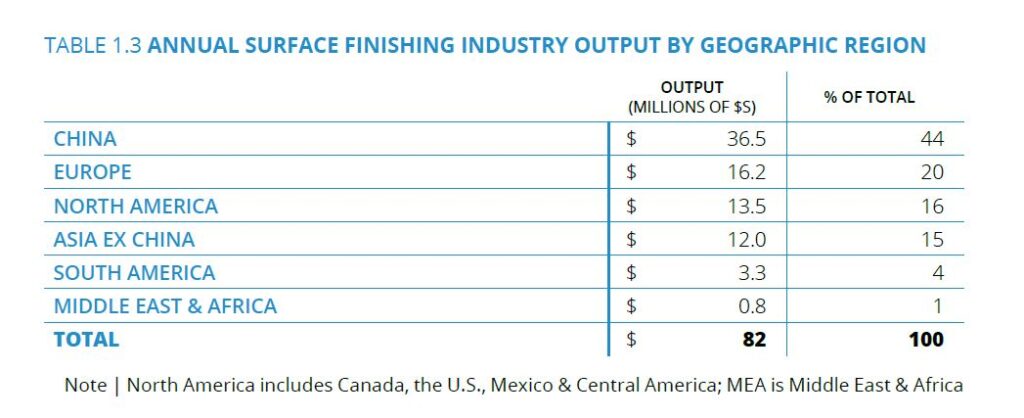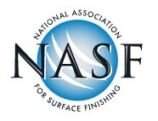THE SURFACE FINISHING INDUSTRY IN THE UNITED STATES ECONOMIC IMPACT STUDY
The surface finishing industry includes a wide array of products that are used to finish metal and plastic substrates. Key industries in the United States economy are reliant on a strong surface finishing industry. The automotive industry, including electric vehicles, renewable energy sources such as wind and solar, medical equipment, aerospace, military, semiconductor chip manufacturing, printed circuit boards, consumer electronics, and energy & mining are all reliant on a strong and successful surface finishing industry. Virtually all manufacturing industries are reliant on surface finishing for their products.
Not only is the surface finishing industry a critical part of the United States manufacturing economy, but it also results in longer lasting parts and thus contributes to less waste and the creation of a more sustainable and environmentally friendly economy. Automobiles, aerospace equipment, hardware fixtures all last longer because of the contributions of the surface finishing industry. Another important contribution of the surface finishing is perhaps its most important; it improves the health and safety of everyone. Braking systems on cars, machinery, and manufacturing equipment are all more reliable and safer due to the surface finishing industry. Medical equipment used in sensitive and critical procedures is also reliant on a strong and vibrant surface finishing industry in the United States.
The surface finishing industry is vital to the United States economy. It contributes a significant amount of economic activity, creates good paying jobs and is an anchor to the United States manufacturing economy. As companies consider bringing more manufacturing back to the United States in the post-Covid era, having a strong surface finishing industry is critical. One example of this is the current semiconductor chip capacity shortfall. As companies work to build more chip capacity in the United States, a strong surface finishing industry that can meet the advanced technological needs of this industry are critical. As such, it is a key industrial market in helping the United States maintain its economic competitiveness.

While the surface finishing industry touches a wide variety of products and industries and is critical to sustainability and competitiveness of the United States economy, it is often overlooked. It is a driving economic force with estimated GDP impact of $9.9 billion and generating a total of over 167,000 jobs. This report focuses on the economic impacts of the surface finishing industry and reveals the importance of surface finishing to the United States economy.
The surface finishing industry is one of the most heavily regulated in the United States. The use of chemicals and need for sustainable business practices is critical to the success of the industry. As such, the surface finishing industry continues to invest in new technologies by developing new product formulations that are more environmentally friendly.
Economic impacts are defined as changes to an economy as a result of a specific undertaking or activity. With those activities come benefits impacting the size and structure of an economy. This happens as goods and services are produced and purchased resulting in direct inflows of capital for construction of new facilities or delivery of new and better services. Economic output relates to the gross revenue from goods or services produced by an industry, while the “value-added” by an industry -the industry’s contribution to Gross Domestic Product – measures the value of goods and services produced less the inputs from other industries used in producing the industry’s output. The ‘output’ of goods noted in this report is defined as the value, as measured by revenues or receipts of goods produced or imported and sold in the United States market.
A summary of the economic impact that the surface finishing industry has on United States shows:
- Annual Direct and Indirect Output of $21.67 billion/year
- Surface Finishers Revenue of $10.7 billion/year
- Total Direct and Indirect Estimated Employment of 108,874
- Total Direct and Indirect Wages and Salaries of $7.3 billion/year
- Annual Induced Employment estimated to be 59,117
- Total Induced Wages and Salaries of $3.43 billion/year
- Annual Federal, State, and Local Tax Revenue of $2.25 billion/year
- Annual GDP Impact of $9.9 billion/year
Tables 1.1 and 1.2 summarize the data noted above.
TABLE 1.1 SUMMARY OF ECONOMIC IMPACT OF SURFACE FINISHING
TABLE 1.2 SUMMARY OF TAXES PAID PER YEAR

At $10.7 billion/year, the output of the United States surface finishing industry represents 12.4% of the global market. The combined United States Canada, and Mexico or North American market represents an estimated 16.5% of the global surface finishing industry. This puts North America as the third largest regional surface finishing market globally after China and Europe. Table 1.3 provides the Output by region of the surface industry.
TABLE 1.3 ANNUAL SURFACE FINISHING INDUSTRY OUTPUT BY GEOGRAPHIC REGION


